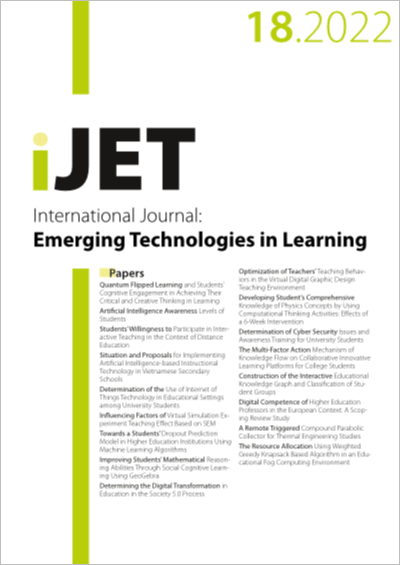Quantum Flipped Learning and Students’ Cognitive Engagement in Achieving Their Critical and Creative Thinking in Learning
DOI:
https://doi.org/10.3991/ijet.v17i18.32101Keywords:
quantum flipped learning model, cognitive engagement, critical thinking, creative thinking, physic learningAbstract
The 21st century as the information age implies that everyone, including students, must be literate in the development and advancement of knowledge-based information and communication technology. That is, students in schools as early as possible must be invited to build 21stcentury knowledge and skills, namely 4C skills. To accommodate this, the learning model must accommodate student centered learning models, one of which is quantum flipped learning (QFL) as a substitute for direct flipped learning (DFL). The aims of this study were 1) to analyze the main and interactive effect between the QFL model vs. the DFL model and students' cognitive involvement on their critical and creative thinking in learning physics. To achieve this goal, experimental research was conducted using a post test only control group design. The population of this research is high school students of class XI SMAN 4 Singaraja, and the sample is 4 classes selected by class random technique. The research data were collected with critical thinking tests, creative thinking tests, and cognitive engagement questionnaires. The research data were analyzed using two-way multivariate analysis of variance. Hypothesis testing was carried out at a significance level of 5%. The results showed that 1) critical thinking and creative thinking of students who studied with the QFL model were higher than students who studied with the DFL model, 2) students who had high cognitive engagement showed critical thinking and creative thinking skills that were not different from students who had low cognitive engagement, 3) there is no interactive effect between the learning model and students' cognitive involvement on critical thinking and creative thinking. The implication of this research is that to achieve optimal critical thinking and creative thinking, physics learning will be better if using the QFL model, students who have low cognitive engagement to be guided and motivated in learning to be able to increase their cognitive engagement in learning, both levels of cognitive involvement students are accommodated by both models.
Downloads
Published
How to Cite
Issue
Section
License
Copyright (c) 2022 Ketut Agustini, I Wayan Santyasa, I Made Tegeh, Gede Saindra Santyadiputra, I Nengah Eka Mertayasa

This work is licensed under a Creative Commons Attribution 4.0 International License.


